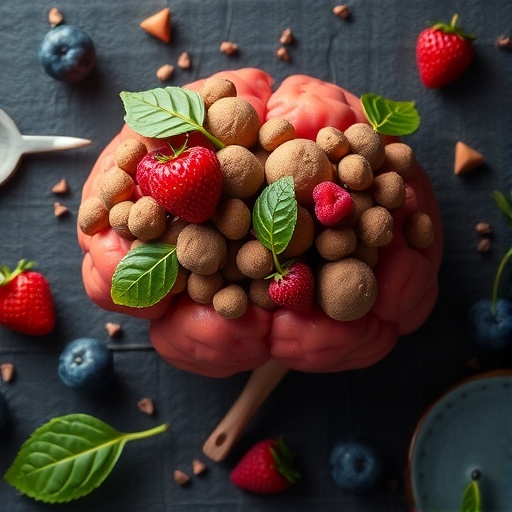In a groundbreaking study published in the September 2025 issue of Current Research in Food Science, researchers from the Shibaura Institute of Technology in Japan have unveiled a fascinating neurological mechanism triggered by astringent flavanols—plant-derived polyphenols commonly found in foods such as cocoa, red wine, and berries. Despite longstanding recognition of flavanols’ cardiovascular benefits and their potential to enhance cognition and memory, a critical gap has persisted due to their notoriously poor bioavailability. This raises the perplexing question: how do flavanols exert significant effects on brain function when such a small percentage is actually absorbed into the bloodstream?
Addressing this conundrum, the investigative team, led by Dr. Yasuyuki Fujii and Professor Naomi Osakabe, posited an innovative hypothesis: the astringent taste of flavanols might serve not merely as a sensory experience but as a direct neurological stimulant. Their research suggests that the sensory perception of astringency transmits signals via sensory nerves directly to the central nervous system, effectively “firing” the brain in ways that extend beyond classical pharmacokinetic pathways of absorption and distribution.
The team employed an experimental framework using 10-week-old murine models, administering oral doses of flavanols at concentrations of 25 mg/kg and 50 mg/kg. Behavioral assessments conducted post-administration revealed noteworthy enhancements in motor activity, exploration, and cognitive domains such as learning and memory, relative to control animals given distilled water. These observations align with an increase in neurotransmitter activity specifically within the locus coeruleus–noradrenaline (LC-NA) system, an integral neurochemical network implicated in arousal, attention, and stress responses.
Delving deeper into neurochemical dynamics, the researchers detected elevations of dopamine and its precursor levodopa, as well as norepinephrine and its metabolite normetanephrine, within the LC-NA circuit shortly after flavanol ingestion. These catecholamines are pivotal in modulating central nervous system states connected to motivation and vigilance. Moreover, the enzymatic machinery responsible for noradrenaline synthesis—comprising tyrosine hydroxylase and dopamine-β-hydroxylase—and for neurotransmitter transport, namely vesicular monoamine transporter 2, exhibited upregulated expression, signifying an augmented noradrenergic signaling capacity triggered by astringent flavanol exposure.
In parallel, biochemical assays evidenced increased urinary excretion of catecholamines, hormones typically elevated in stress states, further supporting the notion that flavanols act as moderate physiological stressors. Correspondingly, molecular markers such as c-Fos, a transcription factor indicative of neuronal activation, and corticotropin-releasing hormone (CRH) exhibited elevated expression in the hypothalamic paraventricular nucleus (PVN), a critical neuroendocrine hub orchestrating the hypothalamic-pituitary-adrenal axis and autonomic nervous system responses.
The physiological cascade initiated by flavanol-mediated sensory stimulation effectively resembles the central and peripheral responses elicited during physical exercise. Activation of the LC-NA system projects noradrenaline to the hypothalamic preoptic area, suppressing sleep while enhancing wakefulness. Simultaneously, dopaminergic and noradrenergic projections to the hippocampus heighten memory consolidation and cognitive function. Peripheral activation of the sympathetic nervous system concomitantly escalates cardiovascular circulation and metabolic rate, aligning with the body’s adaptive response to mild stressors.
Crucially, this research sheds light on the paradox of flavanol inefficacy when judged solely by bioavailability metrics, revealing that the sensory properties intrinsic to certain flavanols bypass classical absorption-based paradigms, instead utilizing a neurophysiological signaling axis to modulate systemic physiology. This discovery not only redefines the framework through which we understand flavanol action in the brain but also opens pioneering avenues in sensory nutrition—a discipline integrally linking taste perception with neurological and systemic health outcomes.
These findings carry significant implications for innovation in food science and functional nutrition. By harnessing the inherent astringency of flavanols, future dietary interventions and next-generation food products can be engineered to optimize sensory-driven neuroactivation, potentially improving cognitive health, alertness, and autonomic balance without relying solely on pharmacological absorption.
Moreover, the study explored the intersection of gustatory input and central nervous system activation, highlighting the brain’s capacity to interpret and respond to complex chemical stimuli with systemic physiological changes. This finely tuned communication pathway involving hypothalamic CRH neurons, locus coeruleus noradrenaline networks, and downstream autonomic effectors showcases the sophisticated integration of sensory input in maintaining homeostasis and adaptive stress responses.
In contextualizing the broader health implications, the research suggests that moderate flavanol intake might serve as a non-pharmacological strategy to enhance mental acuity and physiological resilience, akin to the well-documented benefits of regular physical exercise. This concept holds promise for populations at risk for cognitive decline or metabolic dysregulation, offering a novel nutritional approach grounded in sensory neurobiology.
Dr. Yasuyuki Fujii emphasized the translational potential of this work, stating, “Our findings indicate that the physiological and neurological benefits attributed to flavanols extend beyond their systemic absorption. The astringent taste itself acts as a neuro-stimulatory agent, triggering central nervous system pathways that influence behavior and autonomic regulation.” This paradigm shift underscores the importance of considering taste modalities as active components in the health-promoting properties of dietary bioactive compounds.
Undoubtedly, this landmark investigation propels flavanol research towards a more nuanced understanding of sensory-induced neurophysiology. It encourages a reevaluation of how polyphenolic compounds interact with the human body, prioritizing sensory experience as a critical factor in their efficacy. Future research directions may explore the dose-dependent thresholds of sensory stimulation, long-term effects on cognitive and metabolic health, and the potential synergistic effects of combined sensory and bioactive food components.
In conclusion, the Shibaura Institute of Technology team has successfully illuminated the neurobehavioral and autonomic regulatory role of astringent flavanols via sensory pathways. This discovery marks a substantial advancement in the nexus between food science, neuroscience, and nutrition, paving the way for innovative interventions that leverage the sensory modality to enhance overall health and cognitive function.
Subject of Research: Animals
Article Title: Astringent flavanol fires the locus-noradrenergic system, regulating neurobehavior and autonomic nerves
News Publication Date: 11-Sep-2025
References: DOI: 10.1016/j.crfs.2025.101195
Image Credits: Dr. Yasuyuki Fujii from Shibaura Institute of Technology, Japan
Keywords: Neuroscience, Nutrition, Cognitive neuroscience, Biochemistry, Physiology, Food science, Sensory perception, Health and medicine
Tags: cardiovascular benefits of flavanolscognitive enhancement through dieteffects of astringent compoundsflavanol bioavailability challengesflavanols and brain functionflavanols and memory improvementflavanols and stress responseinnovations in nutritional neuroscienceneurological mechanisms of flavanolspolyphenols in food scienceresearch on flavanols in cocoa and winesensory perception and brain stimulation





